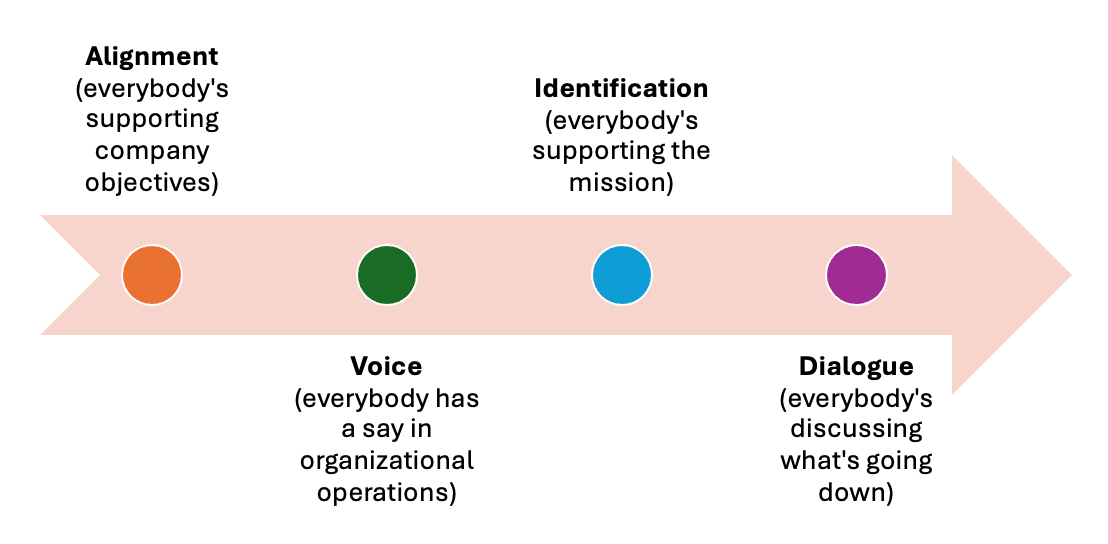The Managers Are Breaking Down in 2025
A new Gallup study shows mid-level managers are disengaging faster than any other kind of worker. Senior leaders need to strengthen their internal communication to support those dispirited managers.
You could just keep scrolling your inbox, looking for a task to finish in the next five minutes. That would make you feel better. For a second.
Or you could read this work-culture newsletter and discover how to keep your emotionally distant manager from breakdown in Q3.
Last week, I took a late summer break with family in Interlochen and then helped my son move into a college apartment in St. Louis.
Spending so much time on I-55 between Michigan and Missouri got me thinking about the relentless traffic at work—and how we expect mid-level managers to keep right on trucking, long after they can’t even.
Let’s talk about that problem and find some solutions in this week’s Mode/Switch. Thanks for checking this out. I appreciate you!
First, a quick parable of the obvious but overlooked.
A truck driver got stopped a few years ago by a police officer on (let’s say) I-55—a cop with shiny sunglasses and a strong suspicion the trucker was carrying illegal substances. But a thorough search of the tractor trailer turned up exactly no contraband. A month later, the same cop stopped the same trucker and still found nothing. Reluctantly, he waved the trucker on down the road.
The stop-and-search went on for years, until finally, one day, the cop pulled him over and said, “Look, buddy: this is my last day at work. I know you’re smuggling something. But can’t figure out what. Look, I’m not gonna turn you in. I just want you to tell me what you’ve been trafficking.”
The driver looked through his bug-stained windshield for a few seconds, smiled slowly, and then said, “It’s trucks, officer. I been smuggling trucks.”
A big datapoint in Gallup’s new workplace study
It’s a story that came to mind after reading this year’s State of the Workplace Report. As a reader of the Mode/Switch, you’ve seen me discuss worker disengagement before (or you’ve read about it in the Harvard Business Review). It’s a huge problem. Last year, employee engagement dropped two percentage points. That’s a decline we’ve only seen twice since 2013. The other time it happened? 2020. As the Gallup researchers note, “Last year’s two-point drop in engagement was equal to the decline during the year of COVID-19 lockdowns and shelter-in-place orders.”
So all that leads me to think that, in our inspections of worker disengagement, we’re missing the exhaustion of managers. Looking for contraband, overlooking the truck.
Before 2024, mid-level managers had been trucking along at 30% engagement But last year, managerial engagement dropped three full percentage points. The Gallup researchers note: “No other worker category — male or female, young or old — experienced as significant a decline.”
The intergenerational team at The Mode/Switch Pod would nod their heads at another data point: among young Millennial and Gen Z managers in 2024, engagement dropped as much as five points.
Why managers can’t even
If company executives pop the hood on mid-level management, they’ll find plenty of explanatory factors:
The Gallup report gave me that list (though as you can see from the links, they’re not alone in raising the alarm). What the Gallup authors did not talk about was the detachment of senior leadership. Yesterday, a Mode/Switch reader texted me to critique the detachment of American leadership culture. I don’t have definitive evidence to confirm that reader’s hunch. But my research this summer into career shock has provided initial support.
One writer who’s addressing this problem head on is Jenni Field. Her book Nobody Believes You is a lovely, short, highly readable discussion of leadership blindspots.
Leaders are watching their companies in the rearview. But you know what’s in their blind spot? The coming breakdown of mid-level managers.
The Gallup authors note: “In an era where executives and employees seem farther apart than they have been in years, managers are handed an almost impossible task of making it all work in the real world.”
So, what can be done? I’d like to recommend a mode switch from external to internal communication. When your organization’s under stress, it’s easy to say, “We need to get better stories out into the world about all the great work we’re doing!” And you do. But improving your internal communication is just as important, if not more so. Because if you don’t strengthen your workers—and especially the discouraged managers leading those workers—you won’t have good work to tout.
Why better internal comms can help
If you’re a senior leader, you’ll want to keep an eye not just on how engaged your employees are, but also on how well-supported your managers are. Too many managers are “accidental bosses” who receive little or no support or training.
Your organization may need to build out months of managerial training for your rising leaders. But even before that programming’s developed, companies can begin improving internal communications with their managers right now. That will mean paying attention to four aspects of organizational interaction outlined by Kevin Ruck: Alignment, Voice, Identification, and Dialogue:
Ruck calls this the AVID Model. But here’s where this week’s mode/switch gets tricky. It’s easy to notice how your workers need alignment, identification, voice, and dialogue, but it’s hard to notice how mid-level managers are running out of avidness all over the office. The decline in managerial engagement is a bigger problem than it looks. As the Gallup study notes, “If managers are disengaged, their teams are, too. This relationship is so strong that it shows up in country-level data: Countries with less engaged managers are more likely to have less engaged individual contributors.”
My recommendation: use Ruck’s model to think through internal communication with mid-level managers. Those managers (not just their teams) need margin in their work to develop their own alignment and identification. Those managers (not just their teams) need room to develop their own voice and a chance to join the dialogue that builds meaning and purpose in the company.
When we think of internal communication as a unilateral blast from senior leaders to everybody else, we tend to treat managers as the supply chain between senior leadership and on-the-ground employees. We’re like that oblivious cop in the opening story: we think the only thing mid-level management’s capable of is carrying stuff. But managers aren’t just corporate carriers. They are culture creators.
Speaking to rather than seeing through
I’ve had my own blindspots when it comes to management. Once I had a team leader who struck me as coldly dispassionate, a technocrat with low emotional intelligence. I remember complaining about the manager over drinks one night. My friend squinted at me over his glass of bourbon and said, “They need an ally in your organization.”
That one comment made me look at what I usually look through. It’s easy to complain about the cracks in mid-level management, as you might a windshield. But offering closer attention and greater alliance to mid-level managers—thanking them, celebrating their achievements, asking them non-reactive questions when they bring bad news—are good ways to support organizational wellbeing in 2025.
Check out the latest episode of the Mode/Switch Pod
The team discusses art in the intergenerational workplace—a topic we found extra interesting, because three of the four of us had just moved into blank new office spaces. What should we put on those bare walls?
But even if you’ve not moved into a new office recently, you will want to know that some art can cost your workers cognitive wellbeing.
Bad art creates visual gaslighting.
We learned that term from our guest Dr. Vasu Tolia, a former pediatric gastroenterologist now turned visual artist. Her paintings build resilience, strength, and vibrant organizational community.
Ken Heffner, our Boomer, Emily Bosscher, our Xennial, LaShone Manuel, our Millennial, and Madeline Witvliet, our Gen Z discuss the surprising business outcomes of workplace art.
You can see Dr. Tolia's art at her website. She also has an active presence on LinkedIn.




